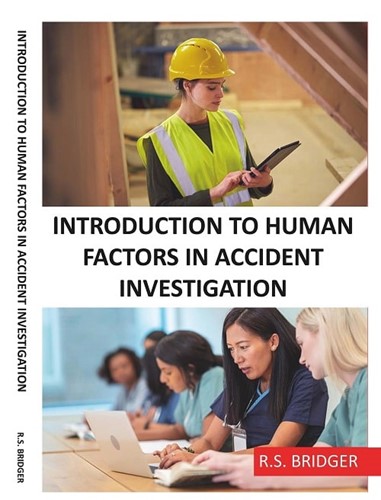Book review by Phil Pinnington CMIOSH, Audit and consultancy manager at the British Safety Council
Features
Introduction to Human Factors in Accident Investigation By Dr Robert Bridger
There have been many research papers published in recent years on the importance of properly considering human factors when conducting accident investigations.
Robert Bridger is a consultant and author in human factors, and his new book aims to provide an accident investigator with the key information and tools to start thinking about the human elements that may have caused – or contributed to – an accident or incident.
The book provides practical advice that can be applied during an investigation to consider the environmental, organisational and job factors (and the human and individual characteristics of the workers involved), that may have played a part in the root causes of the incident. The reader can then start to address these factors – for example, by looking at whether a job has been designed to enable people to work safely, or if there are gaps in workers’ knowledge, training and even attitudes to working safely.

In the opening chapter Robert gives us a very helpful General Human Factors Checklist. Under 11 headings, this sets out the key areas to consider during an investigation. These include analysis of the job; the physical and mental demands of the task; interactions between workers and machines and the design of the workplace. These (and other human factors), can be causative factors in accidents if they are not properly considered and managed during the design, planning and ongoing monitoring of work tasks. The checklist has simple ‘closed’ questions (such as ranking each factor from ‘very unlikely’ to ‘very likely’), to help the reader decide how detailed the investigation of each factor needs to be.
Robert reminds us there has been a huge growth in the use of new technologies. Although many of these are claimed to be infallible, he rightly warns that many new and emerging technologies still rely on human intervention to some extent – which brings risk of mistakes that can contribute to accidents.
Robert also sets out what he regards as the core competencies anyone undertaking an investigation must hold. A simple-to-follow (but detailed) competency development matrix clearly describes these essential skills – whether the investigator is carrying out simple ‘entry level’ investigations or detailed ‘expert’ investigations of more complex incidents, where multiple underlying problems may have contributed to the accident. This matrix could be used as a roadmap for additional professional development, setting out the skills to gain to be able to more effectively consider human factors during investigations.
Robert makes very good use of well documented major accidents to show the role human factors (including human error), played in causing the incidents. For instance, he applies his human factors approach to the 1987 Herald of Free Enterprise ferry disaster, and shows how, if applied, his techniques would reveal the human errors that led to the loss of 189 lives.
Robert effectively explores the people factors that can often be underestimated or overlooked when conducting an investigation. Many of the observations, such as job design, repetition and stress, will be familiar to many health and safety practitioners.
The book is written in an easy-to-follow style and format, and includes question sets that can be used during a simple accident investigation. This is a useful way to practice some of the methodologies offered in the book.
The publication offers both a structure and rationale in how to ensure that human factors are considered when investigating incidents with both a high and low impact – from serious to lower harm events. It is a useful reference tool both for newly qualified safety practitioners or as part of a qualified and experienced safety practitioner’s continuing professional development.
The book can be purchased at: amzn.to/33BgOHX
FEATURES

Why line managers play a vital role in workplace wellbeing
By Marcus Herbert, British Safety Council on 03 September 2023
The behaviours of line managers can have a positive or negative impact on employee health, wellbeing and engagement, so it’s vital managers get staff feedback on whether their management style is supportive or negative, and have regular check-ins so workers can raise concerns about their wellbeing.

Watercooler Event to hone in on eight trends in employee health and wellbeing
By Claire Farrow, Make a Difference Events & Media on 15 April 2024
The free-to-attend Water Cooler Event at ExCeL London on 23–24 April will see more than 6,000 workplace experts coming together to explore the latest thinking, solutions and best practice for supporting and boosting employee wellbeing, diversity and workplace culture.

Sedentary working and how to combat the ‘sitting disease’
By Gavin Bradley, Active Working on 05 April 2024
Prolonged and excessive sitting poses a major risk to our health, but the Get Britain Standing campaign and On Your Feet Britain Day on 25 April are a great way of encouraging workers to sit less and move more.



